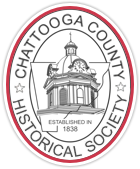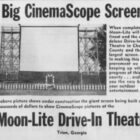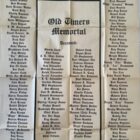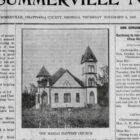The Rock Garden of Dr. F. W. Hall, an early Chattooga attraction

Dr. F. W. Hall is shown looking through the correspondence related to his rock collection. Dr. Hall moved his medical practice to Summerville from Holland in 1918. His home “Restawhile” was located where the Bobby Lee Cook law office is today.
His hobby is Rock Formation and Rocks from Ancient and Secluded Sections of the World Is Now Becoming Internationally Recognized.
To be original, to be natural and to do something different has been his life long proclivity of Dr. F.W. Hall, who during the last few years has collected and has on exhibition in Summerville, Georgia one of the most interesting possessions every brought together. These rocks come from every section of the globe; from the high mountains, from the low valleys, from the dales, from the low lands, the plains and every foreign county and every state in the Union; from the tombs of ancient countries and from the tombs of famous Americans.
These rocks are now on exhibition in the yards of his home and are arranged in rows beginning with the first state to ratify the constitution and coming down to the District of Columbia, which adjoins a concrete national emblem.
In gathering these rocks together Dr. Hall’s correspondence ranged from the late Senator Huey Long to Mahatma Gandhi, which the doctor admits is a wide range in scope of material personal makeup.
Louisiana’s Kingfish contributed a stone from “the only rock quarry in the state at Winfield, La. Kingfish,like the senator wrote Dr. Hall that he was “sending your letter to Gov. O.K. Allen who was raised with me. I am asking the governor if he won’t arrange to have a stone suitable for your rock garden sent to you by express.”
Two of the most prized stones in the collection come from an aide of the Duke of Glocheste,son of the King of England, during his honeymoon trip in New Zealand.

Dr. Hall and a workman are shown finishing up a display. In the Summerville News it says one of the stones to Dr. Hall’s right is painted “Ted Halke.” It is the Minnesota stone. Halke is the is the champion of Cornhusker of the middle west. Tennessee is represented by the a piece of the hearthstone from the first economics building at Alpine.
Ivan A. Elliott, of Birch Road, Pukeekabe, New Zealand, sent one rock from Mount Eden and the other from Franz Josep Glacier. The Mount Eden rock was found by Elliott at the bottom of the crater, which is the highest extinct volcano in the Aukland district. He said he cycled thirty miles to get the stone. Elliott wrote that the Franz Joseph glacier rock was given him by this father, and was found on one of the numerous gold claims near the Walls River flowing from the glacier.
Another highly prized rock is a piece of an ancient Grecian tomb that is connected with the temple recently discovered by archeologists seeking the solution of the Eleusinian mysteries, one of the most important features of the life of ancient Athens. This rock, Dr. Hall said, comes from the Tomb of Pyre, one of the most beautiful women of antiquity who is supposed to have passed as the Earth Goddess’s stolen daughter.
From France the Hall collection boasts a rock from the Port of Sainte Nazaine, where thousands of doughboys landed in 1917. He obtained this from Daniel Paul Ryan, former medical corps trooper, of Chicago and Pittsburg , who remained behind in France and was the subject of a wire story April 19,1935.
Indian Legans Retold
The legends of the Indians of the United States of the Aztecs of Mexico and many another tribe and race are retold by the physician as he fondles his rocks.
Out from south Texas he obtained a piece of the wall of the Alamo where a gallant band defended unto death that old Spanish mission near what is now San Antonio against the overwhelming forces of the Mexican commander, Santa Anna in 1836.
Mrs. Edward T. Newell of Chattanooga presented Dr. Hall with a mummified head of an Aztec Indian taken out of a temple 2,500 years old some 500 years ago by the SPaniards under Cortez. The head, which is mounted under glass on on the tiled concrete table is scarcely bigger than a young baby’s fist. Dr. Hall said the ancient process of making the mummies is a lost art, but it greatly reduces the size of the subject. The inclosed may is surrounded by Indian arrowheads found near Summerville.
Another rock with an interesting history is one from the old Cherokee fort ten miles from Chatsworth, Ga. This fort, Dr. Hall Explained, was built partly of brick shipped from England to Savannah and packed on the backs of Indians to the spot.
Old Erin’s representative in the Hall collection is a rock from Culdafbay, County Donegal, Irish Free State, sent by George W. Tipping, philatelist of Londonderry, North Ireland.
A stone from the Greek church at Palestine is the relic from the Biblical land.
An Indian hammer, used in prehistoric times in the far northwest, came to the collection from Mottingen, Washington. It is a light mottled granite round but slightly flattened on two sides, with a grove one-eight of an inch thick around the middle which was used to fasten it to the band by thongs.

Dr. Hall is shown with the 14,000 pound piece of Georgia granite. It and a 10,000 pound piece of marble mark the end of the Hall park.
The Ohio rock is a crystal form from Flint Ridge about 40 miles east of Brice. Ohio. The vicinity was to named because the Indians dug flints for arrowheads from the territory.
Petrified wood makes Arizona’s contribution. It was sent by Walter Runke, postmaster at Flagstaff, from Navajo Indian reservation and is regarded as a beautiful pice of stone.
Out in Idaho a little boy 12 hours of age made news last inter with this dog and sled. Dr. Hall wrote him and the boy, W.E Jones of Roberts, Idaho sent a piece of “Plain lava rock, not such a pretty rock, but native to Idaho.”
The French influence in the middle west is represented by the stone from Illinois, which was dug out of the bluffs along the Mississippi river hear the site of old Fort Chartres, which was the hub of French activity in 1760.
Intensely interested in his project, Dr. Hall likes to have visitors and has set Wednesday and Sundays as “visiting days” at his home on the main street of Summerville. His attractive home, “Restawhile,” set in a beautiful yard filled with huge old maples and other trees, with his “outdoor living room” and the rock collection as hits high points.
A 14,000 pound slab of Georgia marble and another 10,000 pound piece of granite makes the far ends of the yard , which is decorated with plans and flowers taken from the woods set between flagstone paths. Members of his family are equally enthusiastic and proud of Dr. Hall’s collection.
NEW AND VARIED STONES ADDED TO COLLECTION
Mrs.Harry Wharton, Cody Wyoming, neice of Col. Bill Cody, (Buffalo Bill) sent a rock from the tomb of Col. Cody.
Also one from Robert E. Lee’s home at Arlington ,Virginia and one from a school house built by George Washington, still standing at Alexandra, Virginia.
He has one rock from the grave of Patrick Henry and one from Niagara Falls. Another of much interest is from Plymouth Rock, Massachusetts, where our forefathers landed–the Pilgrims. Another of interest is from the Dead Sea: One from Potter’s Field in Jerusalem : also one from the Temple in Palestine.One from Presidents Roosevelt’s home in Hyde Park,NY; also one from the Little White House at Warm Springs, Georgia.




